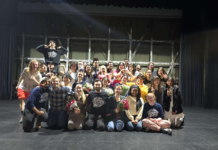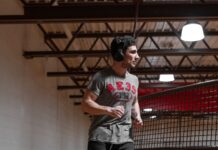In the aftermath of the Hagey Hall stabbing, UW’s PR response via emails to community members and posts on social media threw words like “community” and “safety” around with such speed and ease, you’d think that we were truly up to par with the rest of the province when it comes to safety measures. And yet, we’re the only university of our size in Ontario without a safe-walk program.
It’s not due to lack of need — when I took to Reddit to see if there was any interest in a safe walk home program, I found that most were keen on such a program. In fact, just three days ago at the time of writing this article, one user posted to the university subreddit about a “Scary Hooded, Masked Man in MC/QNC,” reporting multiple encounters of intimidation experienced late at night by herself and two other girls.
“There’s a big hole in the form of no [safe-walk] programs… I know plenty of people who feel worried about walking home from campus late at night who would get a lot of use out of a program like this,” said UW student Daman Gill. Another user, u/summerarcadia, described an encounter with the UW special constable service: “I was feeling dizzy on campus, and I called the campus police if they could walk me to the bus stop. They said no because it would become a liability issue, and said there is no [safe-walk] walk home program anymore on UW…”
Imprint did not receive a response from UW regarding the student’s claim in time for publication.
When we have reached the point that our police are not able to help students without fear of being held liable, and we are choosing not to hold preventative safety measures at risk of it being taken as a legal guarantee, something is wrong with our system.
The kind of language that institutions use when talking about community safety is cold and inhuman, the lingua franca between an HR department and a police station. The word “safe” itself becomes dangerous, a liability, a breakable guarantee. According to Reddit user r/MelonPineapple, orientation leaders were discouraged from using the word “safe” in reference to an off-campus shuttle for first-years because they could not guarantee students’ safety.
So why don’t we have a safe-walk program?
We used to. According to the university, the program was discontinued in 2008 because it cost $100,000 annually in its final years of operation, roughly 18 times what it costs McMaster University to run the Student Walk Home Attendant Team (SWHAT) program. How does McMaster run their SWHAT program on just $5000-6000 annually? When I spoke with program coordinator Jenny Zhao, I found the key to keeping expenses low at McMaster was cultivating a community where people are eager to volunteer their time without monetary compensation, which involved organizing social events, volunteer appreciation merchandise, and making the walk experience as rewarding as possible for volunteers.
This kind of community engagement and trust in a system hasn’t been fostered at UW: the last WUSA election saw a voter turnout of three per cent. “[WUSA’s] a very detached body from the student community, it seems like it does more obstruction of student activity than it does facilitation of student activity,” said Gabriel Gorbet, a physics and astronomy student. He’s not alone in these feelings — in her Imprint article “Dear WUSA: Don’t pretend you care about clubs,” UW student Naomi Francis outlined a number of ways in which WUSA demonstrated what she called “their incapacity to deal with students effectively and respectfully,” citing passive aggressive email exchanges and failure to reimburse club executives within a reasonable time.
We have no community to trust in, so of course a safe-walk program would cost the university an exorbitant amount of money. It’s the same hyper-individualism that would motivates a constable to tell a student to walk home dizzy that would prevent this kind of program from operating effectively. An effective safe-walk program has to be run on the basis of mutual aid and community building rather than blame or liability minimization.
We need a safe-walk program now more than ever.
There’s the obvious effects that these programs have on campuses across Ontario. McMaster students reported using the SWHAT service for a variety of reasons beyond the immediate risk of intimidation. Some students suffering from PTSD find the service an accessibility need in order to participate in late night classes and clubs; some book walks because they got caught in the rain and wanted an umbrella; and some students book walks because they’re in need of company.
It’s worth noting that in the time since the discontinuation of UW’s safe-walk program, the percentage of women enrolled at the university has almost doubled, from 25 per cent to 47.3 per cent, and because women make up the majority of users of safe-walk programs, the need for such a program has likely also drastically increased.
But beyond the immediate, tangible benefits, a safe-walk program is a practical way to resolve the same issues that make it so difficult to facilitate. It would allow for a moderated space where students can rely on one another, creating a true bedrock on top of which we can build the stronger community we are so desperately in need of.
Schools with a walk or ride home safe program:
- Algoma University
- Brock University
- Carleton University
- University of Guelph
- Lakehead University
- Laurentian University
- McMaster University
- Nipissing University
- OCAD University
- Ontario Tech University
- University of Ottawa
- Queen’s University
- University of Toronto
- Toronto Metropolitan University
- Trent University
- Western University
- Wilfrid Laurier University
- University of Windsor
- York University
Schools without:
- Université de Hearst (280 students)
- Université de l’Ontario français (233 students)
- Royal Military College of Canada (1460 full time students)
- University of Waterloo (38,166 students)
Clarification: UW was only unable to provide a response in time to the claim regarding special constables not walking a student home, and provided timely responses to the rest of Imprint’s requests for information. Another implication, that UW labelled the $100,000 cost of the safe-walk program “unseemly,” has also been modified.
Imprint regrets these errors.
































